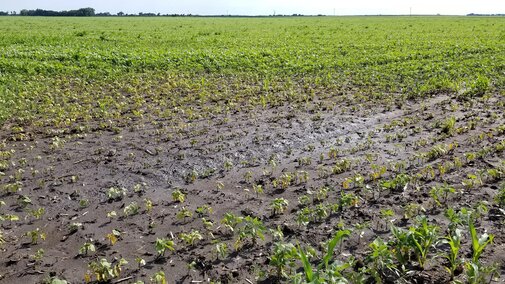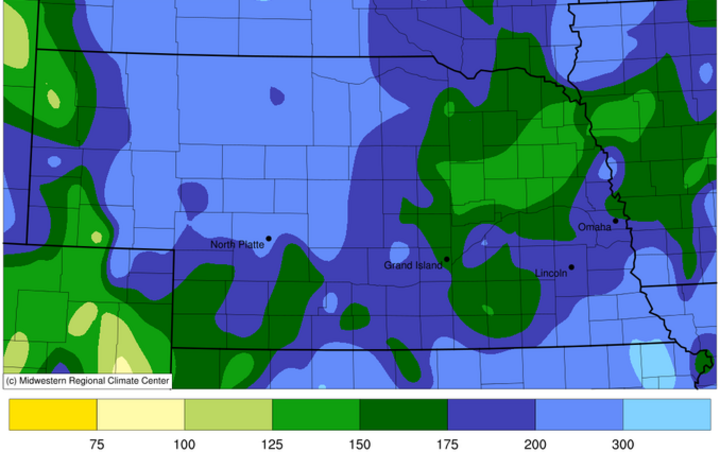
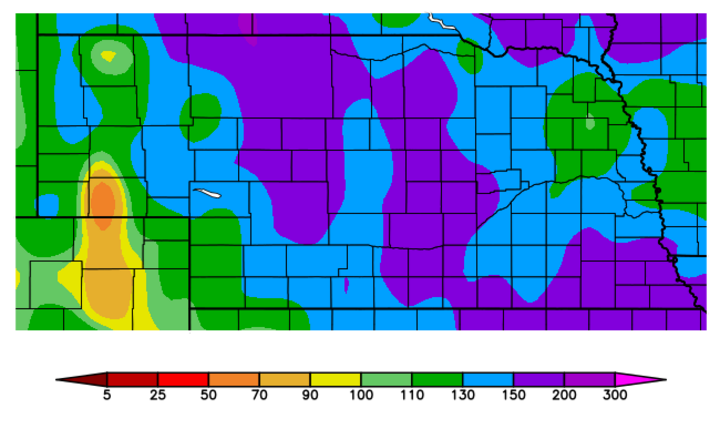
The 2019 growing season has been one for the record books. In May, the entire state experienced above-average precipitation, ranging from 100% to 300% over normal (Figure 2). Longer term, from October 1 to May 28, the majority of the state experienced above normal precipitation (Figure 3). Depending on location, significant moisture events have left soil profiles extremely full or saturated, which is causing more flooding/ponding to occur. As we look at soybean planting and growth across the state, there is significant variation in plant development. For example, crop progress in Holt County ranges from just planted to V1 while in southern Nebraska, beans are at V2-V3.
Plant stage is one of several factors affecting the extent of plant injury due to flooding:
- soybean development stage at the time of flooding,
- frequency and duration of flooding,
- air-soil temperatures, and
- rate of drying after the flood event.
Germinating Seed
For portions of northern Nebraska, a high percentage of soybeans have not emerged. What are the impacts of flooding on germinating seeds? A growth chamber study conducted by Wuebker et al., 2001 explored the effects of early-season soaking on seeds and seedlings.
- Germination was reduced by more than 20% when seed were soaked (fully immersed in water) beginning one day after imbibition (the process in which the seed fills with water); however, there was little difference in germination among soaking times (ranging from 1 to 48 hours).
- When a 48-hour seed-soaking period began two or three days after imbibition, germination was reduced by 50% to 70%, respectively. However, germination was reduced by 25% to 33% when seeds were soaked for 1 to 24 hours, respectively, two or three days after imbibition.
- Other sources stated that severe losses occurred when soybean seed was subjected to four days of soaking prior to germination; however, there were varietal differences in how they responded to flooding.
- Soil temperatures also play an important role in germination responses. Soaking seed from 1 to 48 hours at 59oF reduced germination by an average of 22% less than control plants. However it is important to note that germination was similar no matter how long the seeds were soaked. When temperatures were increased to 77oF and seeds soaked for 48 hours, germination was reduced 40% compared to the control plants. But, when seeds soaked 1 to 24 hours at 77oF, germination averaged 11% less than the control plants. Cooler soil temperatures improve soybean seed viability when subjected to flooding.
Vegetative Stages
In general, soybeans in the vegetative stages can tolerate a fair amount of flooding without major impacts. It is important to note that research on flooding at these stages is divided into either water-logging, where only the roots are flooded, or complete submergence, where entire plants are under water (VanToai et al., 2001). Water-logging is more commonly observed than complete submergence, and in general less damage is observed. Research has shown that soybeans can generally survive for 48 to 96 hours when completely submerged. The actual time frame plants can survive depends on air temperature, humidity, cloud cover, soil moisture conditions prior to flooding, and the rate of soil drainage.
- Cool and cloudy conditions increase survivability.
- Higher temperatures and sunshine increase plant mortality because plant respiration rates increase, depleting oxygen and increasing carbon dioxide levels.
- Saturated soils prior to flooding will result in more rapid soybean mortality because the soil drainage after flooding prevents gas exchange between the rhizosphere and the air above the soil surface.
The injury sustained to fields of soybean following water logging is difficult to assess. In 1990 Oosterhuis et al., reported soybean yield losses of 17% to 43% from water-logging at the vegetative stages. Yield loss is the result of reduced root growth, shoot growth, nodulation, nitrogen fixation, photosynthesis, biomass accumulation, stomatal conductance, and plant death due to diseases and physiological stress (Oosterhuis et al., 1990, VanToai et al., 2994 and 2003). It is important to note that there is a significant amount of genetic variability for flooding tolerance in Maturity Group (MG) II and III soybeans (VanToai et al, 1994) and probably within other maturity groups as well.
Soybeans Diseases that Develop after Flooded Conditions
Saturated soils and flooded conditions promote a number of diseases in soybeans that producers and crop consultants should watch for now and later in the season. Wet conditions are favorable for several pathogens helping them to sporulate, germinate, and/or infect plants. Fungicide soybean seed treatments can provide protection against soilborne diseases commonly observed during flooding. However, it is important to note that seed treatments only protect seeds and seedling for approximately three weeks after planting, depending on product and disease (Wise, et. al., 2016). If environmental conditions are conducive for pathogen infection after that three-week window and a susceptible variety is grown, disease will develop. Below are a few of the diseases that are more common in soybean subjected to flooded conditions.
Pythium Seed and Root Rot
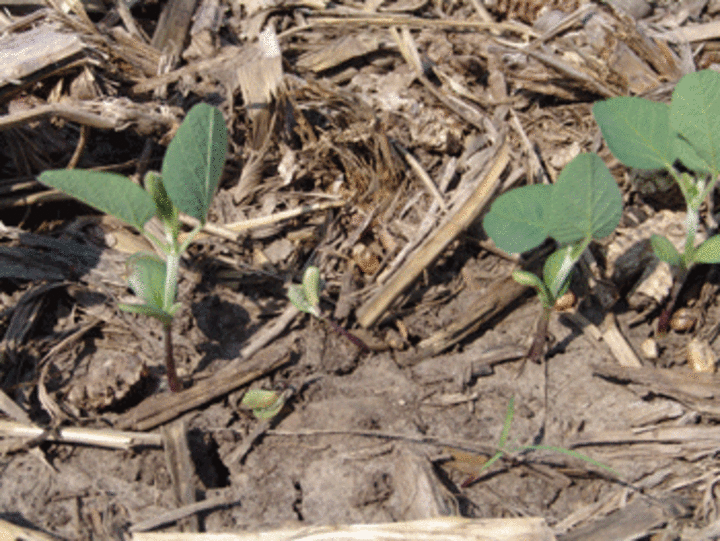
Wet conditions are favorable for Pythium which is our most common seedling disease of soybean in Nebraska. Cooler soil temperatures can make this disease worse as the seedling will be stressed and grow more slowly. Typical symptoms of Pythium include seed decay, pre-emergent seedling rot, and seedling damping off after emergence (Figure 4). If the plant has emerged, it often has a root system where the outer layer can be easily pulled off while the center of the root remains intact.
Phytophthora Root and Stem Rot
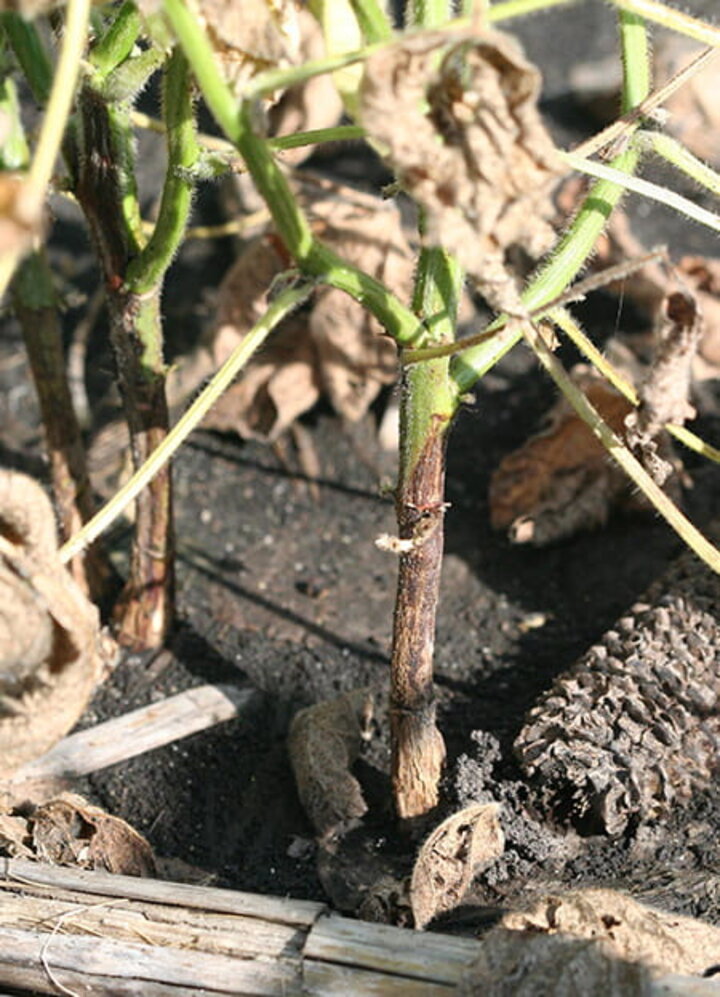
As soil temperatures increase, Phytophthora often becomes more common with heavy rains. Fields with a history of this disease will flare up again when rain events saturate soil profiles. Phytophthora is often indicated when a field was planted with a standard rate of seed treatment, but still has significant stand reduction following wet conditions. Management of Phytophthora requires higher rates of metalaxyl or mefenoxam seed treatments. Ethaboxam seed treatment can also be effective at managing Phytophthora. This is a field-specific issue and usually does not occur as often as Pythium.
Typical symptoms of Phytophthora are seed decay and pre-emergence seedling rot, and seedling damping off after emergence. Typical symptoms on seedlings are darkened stems at the base of the plant starting at the soil line (Figure 5). When cut open, young plant stems often have dark centers. Phytophthora can kill plants at any stage of development through the remainder of the season, but Pythium typically does not kill plants much past the V5 development stage. Both Pythium and Phytophthora are caused by fungal-like organisms, Oomycetes, that require wet conditions and produce swimming zoospores that are attracted to roots.
References
Oosterhuis, D.M., H.D. Scott, R.E. Hampton and S.D. Wullschleger 1990. Physiological response of two soybean [Glycine max, (L.) Merr.] cultivars to short term flooding. Environmental and Experimental Botany. 30:85-92.
Wise, K., Mueller, D., Bradley, C., Chilvers, M., Freijie A., Giesler, L., Sisson, A., Smith, D., and Tenuta, A. 2016. Soybean seed treatments: Questions that emerge when plants don’t. Crop Protection Network 1016.
Wuebker, Eileen Feilmeier, Russell E. Mullen, and Kenneth Koehler. 2001. Flooding and Temperature Effects on Soybean Germination. Crop Science. 41:1857-1861.
VanToai, T.T., Beuerlein, J.E., Schmitthenner, A.F., and St. Martin, S.K. 1994. Genetic variability for flooding tolerance in soybeans. Crop Science 34:1112-1115.
VanToai, T. Y. Yang, P. Ling, G. Boru, M. Karica, V. Roberts, D. Hua, B. Bishop.(2003) Monitoring soybean tolerance to flooding stress by image processing technique. In T.T. VanToai, et al. (ed) Digital Imaging and Spectral Techniques: Applications to Precision Agriculture and Crop Physiology. ASA Special Publication No 66. The American Society of Agronomy. Madison, WI. Pp 43-51.
